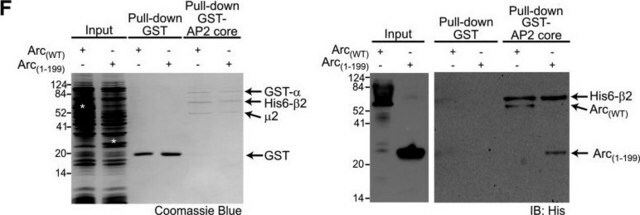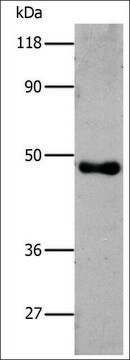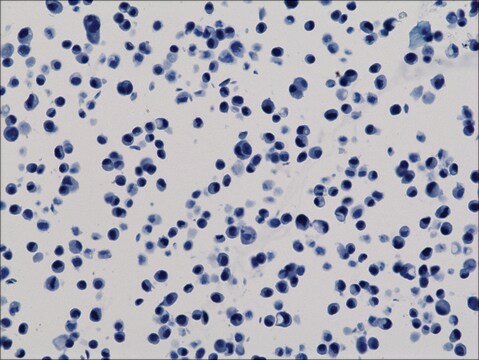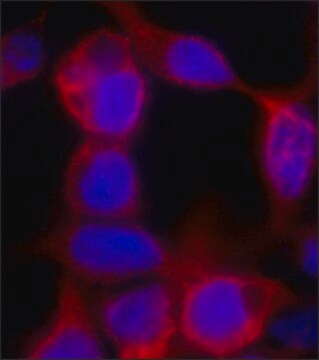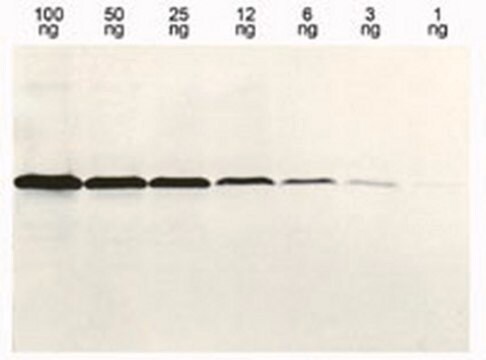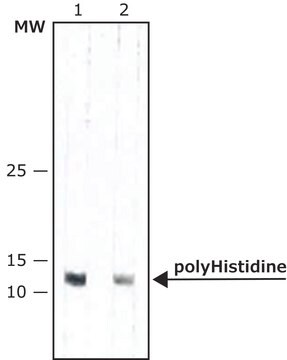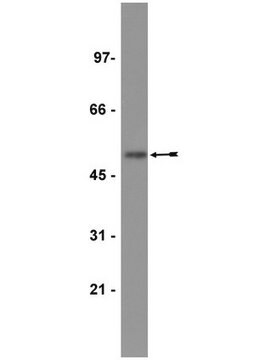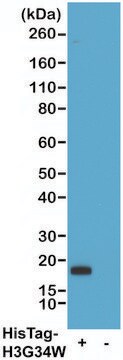11922416001
Roche
Anty-His6
from mouse IgG1
Synonim(y):
chromatografia powinowactwa chelatów metali
Zaloguj sięWyświetlanie cen organizacyjnych i kontraktowych
About This Item
Kod UNSPSC:
12352203
Polecane produkty
pochodzenie biologiczne
mouse
Poziom jakości
białko sprzężone
unconjugated
forma przeciwciała
purified immunoglobulin
rodzaj przeciwciała
primary antibodies
klon
monoclonal
Formularz
lyophilized
opakowanie
pkg of 100 μg
producent / nazwa handlowa
Roche
izotyp
IgG1
temp. przechowywania
2-8°C
Opis ogólny
Anti-His6 is a monoclonal antibody to His6-tagged proteins. Anti-His6 specifically recognizes an epitope of six consecutive histidine residues of both natural and recombinant proteins. The antibody reacts with native and denatured histidine-tagged fusion proteins independent of the location of the histidine-tag in the protein sequence.
Specyficzność
Anti-His6 specifically recognizes an epitope of six consecutive histidine residues (His6) in natural and recombinant proteins. It reacts with both native and denatured histidine-tagged fusion proteins, independent of location of the histidine-tag in the protein sequence. In addition, Anti-His6 preferentially recognizes the C-terminal His6-epitope with high sensitivity. Anti-His6 allows specific and sensitive detection of histidine-tagged proteins irrespective of the expression system used.
The antibody recognizes an epitope of six consecutive histidine residues (His6) in natural and recombinant proteins. It reacts with both native and denatured histidine-tagged fusion proteins, independent of the epitope-sequence location.
Zastosowanie
Anti-His6 is used for the detection of His6-tagged proteins in:
- Immunoblotting (e.g., dot blots and western blots)
- Immunoprecipitation
- Immunoassays (ELISA)
- Immunocytochemistry
- Immunofluorescence
Uwaga dotycząca przygotowania
Stabilizers: BSA
Working concentration: Working concentration of conjugate depends on application and substrate.
The following concentrations should be taken as a guideline:
Working concentration: Working concentration of conjugate depends on application and substrate.
The following concentrations should be taken as a guideline:
- ELISA: for detection 0.1 μg/ml; for coating 1 to 5 μg/ml
- Immunoprecipitation: 0.5 to 5 μg/ml
- Western blot: 0.2 to 0.5 μg/ml
Rekonstytucja
Add 1 ml double-distilled water to a final concentration of 100 μg/ml.
Inne uwagi
For life science research only. Not for use in diagnostic procedures.
Ta strona może zawierać tekst przetłumaczony maszynowo.
Nie możesz znaleźć właściwego produktu?
Wypróbuj nasz Narzędzie selektora produktów.
Hasło ostrzegawcze
Warning
Zwroty wskazujące rodzaj zagrożenia
Zwroty wskazujące środki ostrożności
Klasyfikacja zagrożeń
Aquatic Chronic 3 - Skin Sens. 1
Kod klasy składowania
11 - Combustible Solids
Klasa zagrożenia wodnego (WGK)
WGK 2
Temperatura zapłonu (°F)
does not flash
Temperatura zapłonu (°C)
does not flash
Wybierz jedną z najnowszych wersji:
Masz już ten produkt?
Dokumenty związane z niedawno zakupionymi produktami zostały zamieszczone w Bibliotece dokumentów.
Klienci oglądali również te produkty
Aniek D van der Woude et al.
Microbial cell factories, 15, 60-60 (2016-04-10)
Erythritol is a polyol that is used in the food and beverage industry. Due to its non-caloric and non-cariogenic properties, the popularity of this sweetener is increasing. Large scale production of erythritol is currently based on conversion of glucose by
Michael Kisiela et al.
The FEBS journal, 285(2), 275-293 (2017-11-21)
The human dehydrogenase/reductase SDR family member 4 (DHRS4) is a tetrameric protein that is involved in the metabolism of several aromatic carbonyl compounds, steroids, and bile acids. The only invertebrate DHRS4 that has been characterized to date is that from
Chandrika Canugovi et al.
DNA repair, 9(10), 1080-1089 (2010-08-27)
Mitochondrial transcription factor A (TFAM) is an essential component of mitochondrial nucleoids. TFAM plays an important role in mitochondrial transcription and replication. TFAM has been previously reported to inhibit nucleotide excision repair (NER) in vitro but NER has not yet
Donghyuk Shin et al.
Molecular cell, 77(1), 164-179 (2019-11-17)
The family of bacterial SidE enzymes catalyzes non-canonical phosphoribosyl-linked (PR) serine ubiquitination and promotes infectivity of Legionella pneumophila. Here, we describe identification of two bacterial effectors that reverse PR ubiquitination and are thus named deubiquitinases for PR ubiquitination (DUPs; DupA
Archana Kumari et al.
The EMBO journal, 39(14), e104006-e104006 (2020-06-23)
Cellular studies of filamentous actin (F-actin) processes commonly utilize fluorescent versions of toxins, peptides, and proteins that bind actin. While the choice of these markers has been largely based on availability and ease, there is a severe dearth of structural
Nasz zespół naukowców ma doświadczenie we wszystkich obszarach badań, w tym w naukach przyrodniczych, materiałoznawstwie, syntezie chemicznej, chromatografii, analityce i wielu innych dziedzinach.
Skontaktuj się z zespołem ds. pomocy technicznej
